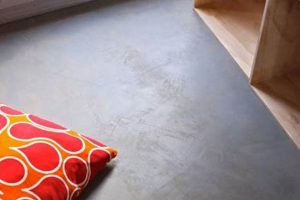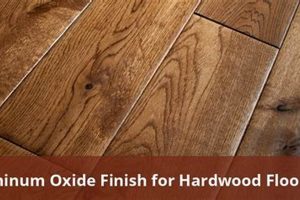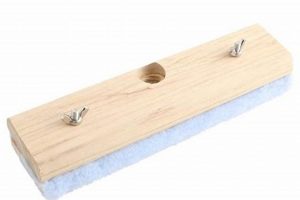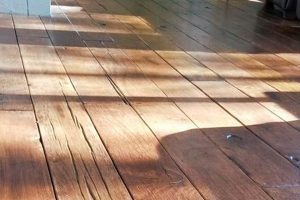A coating derived from naturally occurring oils, waxes, or resins, applied to timber surfaces, enhances the wood’s inherent beauty and provides protection against wear and tear. Linseed oil, beeswax, and shellac are examples of ingredients frequently employed in such formulations. These treatments penetrate the wood fibers, hardening to create a resilient layer.
The significance of such surface treatments lies in their ability to preserve the character of the material while offering resistance to moisture, scratches, and stains. Historically, these finishes were favored for their renewability and environmental profile, as they often utilize renewable resources and emit fewer volatile organic compounds compared to synthetic alternatives. The result is a durable, aesthetically pleasing surface that ages gracefully.
The subsequent sections will detail the specific types, application techniques, maintenance procedures, and potential drawbacks associated with this approach to preserving and enhancing wood floors. Comparisons with alternative finishing methods will also be provided to offer a comprehensive understanding of the options available.
Tips for Achieving Optimal Results
Proper selection and application are critical when using a specific type of surface treatment. The following tips provide guidance for maximizing the benefits and ensuring the longevity of wood floors treated with natural compositions.
Tip 1: Wood Preparation is Paramount: Prior to application, ensure the floor is thoroughly sanded to a uniform grit. Remove all dust and debris using a vacuum and tack cloth. Inadequate preparation diminishes adhesion and aesthetic outcome.
Tip 2: Understand the Product’s Properties: Each product possesses unique characteristics regarding drying time, sheen level, and protective qualities. Consult the manufacturer’s specifications and safety data sheet before beginning the application process.
Tip 3: Apply Thin, Even Coats: Multiple thin coats are preferable to a single thick coat. This promotes proper drying and penetration, preventing surface tackiness and uneven curing. Use appropriate applicators, such as lambswool applicators or lint-free cloths.
Tip 4: Allow Adequate Drying Time: Sufficient drying time between coats and before heavy use is crucial. Follow the manufacturer’s recommended drying times, considering ambient temperature and humidity. Premature use can damage the finish and compromise its durability.
Tip 5: Maintain Consistent Environmental Conditions: Application should ideally occur in a controlled environment with stable temperature and humidity levels. Extreme fluctuations can impact the drying and curing process, leading to inconsistent results.
Tip 6: Regular Maintenance is Essential: Once applied, regular cleaning with appropriate cleaning solutions specifically designed for such treated surfaces is necessary. Avoid harsh chemicals and abrasive cleaners, which can strip the protective layer.
Tip 7: Re-Application as Needed: Depending on traffic and usage, periodic re-application may be required to maintain the protective qualities and aesthetic appeal. Monitor the floor’s condition and address wear areas promptly.
By adhering to these guidelines, users can ensure the long-term performance and beauty of wood floors treated with these types of products. Proper application and maintenance contribute significantly to the lifespan and overall value of the flooring.
The subsequent sections will explore specific applications and common challenges associated with these finishes in various environments.
1. Composition
The composition of a finish directly determines its performance characteristics when applied to wooden floors. Selecting components dictates the final appearance, durability, and long-term maintenance requirements of the treated surface. Therefore, careful consideration of the specific ingredients and their properties is paramount.
- Oil-Based Formulations
Oil-based finishes typically consist of linseed oil, tung oil, or other plant-derived oils. These oils penetrate the wood fibers, hardening to provide protection from within. The depth of penetration enhances the wood’s natural color and grain. Linseed oil, for example, offers a warm, amber tone, while tung oil provides a more neutral appearance. However, oil-based treatments can be slow-drying and may require multiple coats. The composition ratio affects dry time.
- Wax-Based Compositions
Wax finishes, commonly employing beeswax or carnauba wax, create a protective surface layer that imparts a soft sheen. These compositions are often applied over an oil-based treatment for enhanced durability. Wax enhances the wood’s texture and provides a tactile feel. Beeswax, in particular, is known for its natural luster and ability to repel moisture. However, wax finishes require periodic re-application to maintain their protective qualities.
- Resin-Based Solutions
Some finishes incorporate natural resins, such as shellac, to provide a harder and more durable surface. Shellac, derived from insect secretions, offers excellent clarity and adhesion. It dries quickly and can be easily repaired. However, shellac is susceptible to damage from water and alcohol, making it less suitable for high-moisture environments. Other plant based resin may have better outcome.
- Additive Components
Manufacturers often incorporate additives to enhance specific properties. Examples include driers (to accelerate curing time), UV inhibitors (to prevent fading), and pigments (to alter the color). The type and concentration of these additives influence the overall performance of the floor. Careful selection of product is important to consider long-term floor maintenance and safety.
In summary, the selection of components is a crucial aspect of achieving the desired outcome. Each ingredient plays a specific role in determining the finish’s aesthetic appeal, protective qualities, and maintenance requirements. A thorough understanding of these factors enables informed decision-making and ensures the longevity and beauty of wood floors.
2. Durability
The inherent durability of a timber floor is directly influenced by the choice of surface coating. A natural wood floor finish, while often selected for its aesthetic qualities and environmental profile, presents a unique set of durability considerations. The protective capacity of such a product depends on its composition, application, and the nature of the wood substrate. Oils and waxes, commonly found in these products, offer a degree of resistance against scratching and liquid penetration. However, their performance under heavy foot traffic or exposure to abrasive elements differs significantly from synthetic alternatives. For instance, a floor treated with linseed oil may require more frequent reapplication in a high-traffic area compared to one coated with a polyurethane finish.
The durability of naturally derived finishes is also contingent on proper application and maintenance. A thin, evenly applied coating, allowed to fully cure, provides a more robust barrier than a hastily applied, thick layer. Regular cleaning with appropriate, pH-neutral products is critical to preventing the buildup of dirt and grime, which can accelerate wear. Real-world examples demonstrate that floors maintained according to manufacturer guidelines exhibit significantly longer lifespans. Conversely, neglect or the use of harsh cleaning agents can lead to premature degradation, requiring costly repairs or recoating. The durability is in correlation with wood type and proper procedure.
In summary, while finishes derived from renewable resources offer environmental and aesthetic advantages, their durability requires careful consideration. The choice of product, application technique, and ongoing maintenance practices all play crucial roles in determining the longevity of the flooring. Challenges arise in balancing the desire for a natural look with the need for a resilient surface capable of withstanding daily wear and tear. Understanding these trade-offs is essential for selecting a floor finish that meets both aesthetic and functional requirements.
3. Application
The application process is a critical determinant in the performance and aesthetic outcome of a floor coated with natural finishes. A meticulously chosen product can fail to deliver the desired results if applied incorrectly. The application method dictates the finish’s ability to penetrate the wood, adhere properly, and provide uniform protection.
- Surface Preparation
Proper surface preparation is paramount. The floor must be thoroughly sanded to remove existing finishes and imperfections, creating a smooth, even surface. Dust and debris must be meticulously removed to ensure proper adhesion. Incomplete preparation leads to uneven penetration and a compromised finish, requiring premature reapplication. The sanding quality will directly affect the coating quality.
- Application Techniques
The chosen application method impacts the final appearance and durability. Thin, even coats applied with a high-quality brush, pad, or roller are preferable to thick, uneven applications. Each coat should be allowed to dry fully before the next is applied. Improper technique results in drips, streaks, and inconsistent sheen levels. Each technique has a unique result to the outcome.
- Environmental Control
Environmental factors, such as temperature and humidity, play a significant role in the drying and curing process. Application should occur within the manufacturer’s recommended temperature range to ensure proper curing and adhesion. High humidity can prolong drying times and lead to a cloudy or uneven finish. Proper ventilation is essential for reducing airborne contaminants.
- Curing and Drying Times
Allowing sufficient time for the finish to fully cure is essential for achieving maximum durability and resistance. Premature use of the floor before the finish has fully cured can lead to scratching, marring, and reduced lifespan. Adhering to the manufacturer’s recommended drying times is critical. The coating will not be effective if not dried properly.
In conclusion, the successful application of a floor coating requires meticulous attention to detail, proper preparation, and adherence to manufacturer guidelines. A well-executed application ensures the long-term beauty and protection of timber flooring while highlighting its natural character. The time and effort spent in proper application are directly proportional to the longevity and satisfaction derived from the finished floor.
4. Maintenance
The long-term preservation and aesthetic appeal of a floor treated with natural wood floor finish depend heavily on appropriate and consistent maintenance practices. Unlike some synthetic coatings, these finishes often require specific care to ensure their longevity and performance. Failure to adhere to recommended maintenance protocols can lead to premature wear, discoloration, and a compromised appearance.
- Regular Cleaning Regimen
Routine cleaning is essential for removing dirt, dust, and debris that can scratch and dull the finish. A soft broom, microfiber mop, or vacuum with a soft brush attachment should be used regularly. The frequency depends on traffic levels; high-traffic areas require more frequent attention. Neglecting regular cleaning allows abrasive particles to accumulate, accelerating wear and tear. Dust can easily scratch and damage the coating if not routinely cleaned.
- Appropriate Cleaning Solutions
Harsh chemicals and abrasive cleaners should be avoided. Instead, use pH-neutral cleaning solutions specifically formulated for wood floors with natural finishes. These solutions prevent the stripping of the finish and maintain the floor’s natural sheen. Improper cleaning agents can damage the finish, leading to discoloration or requiring complete refinishing. Abrasive cleaners can scratch the flooring materials which causes long term problems.
- Reapplication of Finish
Periodic reapplication of the finish is necessary to maintain its protective qualities and aesthetic appeal. The frequency depends on the type of finish, traffic levels, and maintenance practices. Wax finishes, for instance, require more frequent reapplication than oil-based finishes. Monitoring the floor’s condition and addressing wear areas promptly prevents further damage and maintains a consistent appearance. This reapplication improves the protective barrier and enhances the coating.
- Prompt Spill Cleanup
Spills should be cleaned immediately to prevent staining and water damage. Use a clean, absorbent cloth to blot the spill, avoiding rubbing, which can spread the stain. Water or other liquids left on the surface for extended periods can penetrate the finish and cause discoloration or warping of the wood. Quick cleanup is a must when spills occur, which can greatly increase the coating life.
The maintenance procedures directly influence the longevity and beauty of wood floors with natural finishes. By implementing proper practices, one can preserve the finish, extending its lifespan and maintaining its visual appeal. A commitment to consistent and appropriate maintenance ensures that the floor remains a durable and attractive feature of the space for years to come.
5. Appearance
The visual characteristics imparted by a natural wood floor finish are a primary consideration for homeowners and designers. The finish influences the wood’s color, sheen, and texture, significantly affecting the overall ambiance of a space. The selection of a specific finish directly contributes to the desired aesthetic outcome.
- Color Enhancement
Many oil-based finishes deepen the natural color of the wood, bringing out the warmth and richness of the grain. Linseed oil, for example, tends to impart an amber hue, while tung oil offers a more neutral tone. This enhancement accentuates the wood’s inherent beauty, creating a visually appealing surface. Without proper treatment, the wood will not show its vibrant and full-bodied color.
- Sheen Level
The sheen level of a floor affects the amount of light it reflects and its overall appearance. Natural finishes are available in various sheens, from matte to gloss. Matte finishes offer a subtle, understated look, while gloss finishes provide a more polished and reflective surface. The choice of sheen depends on the desired level of formality and the amount of natural light in the room. It is an important step to make sure the customer gets the desire sheen look they want.
- Texture and Tactility
The application of a finish impacts the texture of the wood, influencing its tactile qualities. Wax finishes, in particular, enhance the wood’s natural texture, creating a smooth, tactile surface. This adds to the sensory experience of the floor, making it more inviting and comfortable. Having a smooth texture and tactile feel can increase comfort and relaxation in your own home.
- Aging Characteristics
Natural finishes age gracefully, developing a patina over time that adds character and depth. Unlike some synthetic coatings that can crack or peel, wood will develop warmth and become its own unique beauty when taken care of. This natural aging process contributes to the floor’s unique charm and enduring appeal. When aging gracefully, it can enhance the warm colors of the coating.
In summary, the appearance is a multifaceted aspect of a natural wood floor finish, encompassing color enhancement, sheen level, texture, and aging characteristics. The careful selection of the right product and application technique can transform a floor into a stunning focal point. The outcome has a significant impact on the overall aesthetic and creates a sense of timeless beauty.
6. Sustainability
The concept of sustainability is fundamentally intertwined with the selection and application of natural wood floor finishes. The cause-and-effect relationship is evident: the choice of renewable, low-VOC materials directly reduces environmental impact. Sustainability’s importance manifests in the reduced depletion of non-renewable resources and lower emissions of harmful chemicals during manufacturing and application. For example, using finishes derived from sustainably harvested trees and plant-based oils, like tung or linseed, supports responsible forestry practices and minimizes reliance on petroleum-based products. Understanding this connection is practically significant because it empowers consumers and builders to make informed choices that align with environmental stewardship.
Practical application of sustainable principles extends to the entire lifecycle of the floor. Durable, naturally sourced finishes, properly maintained, can extend the lifespan of the flooring, reducing the need for frequent replacements and minimizing waste. The use of low-VOC finishes improves indoor air quality, creating healthier living environments. Furthermore, at the end of its life, a floor treated with these materials is more likely to be biodegradable or recyclable compared to those finished with synthetic coatings. An example includes floors finished with beeswax and plant-based oils which can be sanded down and retreated, avoiding complete replacement.
In summary, integrating sustainability into the decision-making process regarding natural wood floor finishes presents both opportunities and challenges. Key insights include the direct positive impact on the environment, the promotion of healthier living spaces, and the reduced waste associated with flooring replacement. However, challenges remain in balancing environmental considerations with cost and performance requirements. Ultimately, the link between sustainability and floor finish selection underscores a commitment to responsible resource management and environmental preservation within the broader context of construction and interior design.
Frequently Asked Questions
The following section addresses common inquiries regarding characteristics, application, and maintenance of a particular floor surface treatment. These responses aim to provide clarity and factual information.
Question 1: What constitutes a natural floor surface treatment, and how does it differ from synthetic alternatives?
A “natural” surface treatment typically comprises oils, waxes, or resins derived from renewable sources. Examples include linseed oil, beeswax, and shellac. These materials are distinct from synthetic alternatives, such as polyurethane, which are manufactured from petrochemicals. The primary differences lie in composition, VOC emissions, and long-term environmental impact.
Question 2: What are the primary advantages of choosing a renewable floor treatment option?
Key advantages include reduced volatile organic compound (VOC) emissions, a lower environmental footprint due to the use of renewable resources, and often, a more aesthetically pleasing and authentic appearance. Furthermore, many renewable finishes can be spot-repaired more easily than synthetic coatings.
Question 3: How does the durability of a floor surface treatment compare to that of synthetic options?
The durability varies depending on the specific product composition and application. In general, some renewable options may require more frequent maintenance and reapplication than certain synthetic coatings, particularly in high-traffic areas. However, advancements in formulations have improved the durability of certain natural options.
Question 4: What specific maintenance procedures are recommended for floors treated with a natural floor surface treatment?
Recommended procedures include regular cleaning with pH-neutral cleaning solutions, prompt spill cleanup, and periodic reapplication of the finish. Avoid harsh chemicals and abrasive cleaners, which can damage or strip the finish.
Question 5: What factors should be considered when selecting a particular type of the floor’s surface treatment for a specific application?
Factors to consider include the level of traffic the floor will experience, the desired sheen level, the wood species, the potential for exposure to moisture, and the aesthetic preferences of the owner. Consulting with a flooring professional is advisable.
Question 6: Is a naturally derived floor finish suitable for all types of wood flooring?
The suitability depends on the wood species and its inherent properties. Certain finishes may perform better on hardwood species compared to softwood species. Always consult the manufacturer’s guidelines to ensure compatibility.
In summary, the selection of a flooring material represents a balance between aesthetic considerations, environmental responsibility, and functional performance. Informed decision-making requires a thorough understanding of the product’s characteristics and the specific requirements of the application.
The subsequent section will explore case studies that exemplify the successful implementation of natural floor treatments in various residential and commercial settings.
Conclusion
The preceding analysis explored the various facets of “natural wood floor finish,” encompassing its composition, durability, application, maintenance, appearance, and sustainability implications. It underscores that selecting such a treatment requires careful consideration of numerous factors, including wood species, intended use, and environmental priorities. Furthermore, the long-term success of this flooring option hinges on meticulous application techniques and consistent maintenance practices.
The decision to employ a “natural wood floor finish” represents a conscious choice, balancing aesthetic desires with ecological responsibility. While challenges may exist in achieving the same level of durability as synthetic alternatives, ongoing advancements in formulation and application continue to enhance its viability. Continued research and development are essential to further refine this approach and solidify its position as a sustainable and aesthetically pleasing flooring solution for the future.







